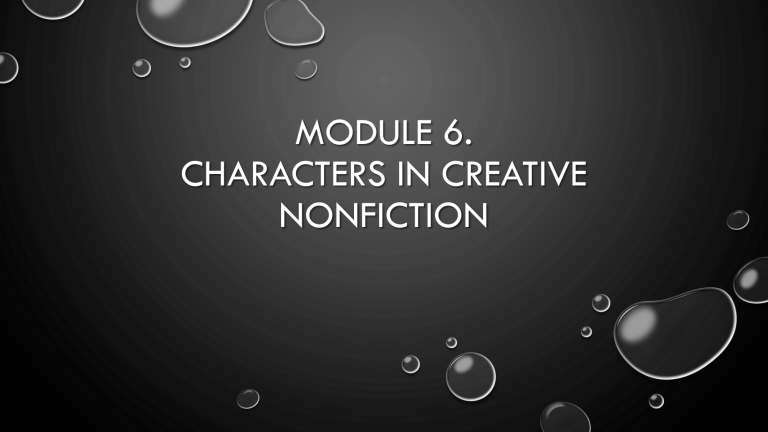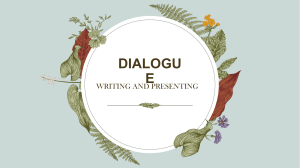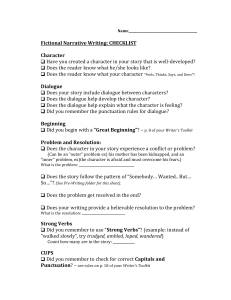
MODULE 6. CHARACTERS IN CREATIVE NONFICTION WRITING A DIALOGUE • If your characters are creatures that talk and act like humans, they will not only entertain your readers. You may use them as metaphor for humans in the real world. You may consider reading Orhan Pamuk’s My Name is Red where a corpse, a coin, and the color red were among the characters who narrated in every chapter of the novel. Based on the ancient Greek drama, characters are identified as the following: • Protagonist – the main character in a narrative • Deuteragonist – the “sidekick” who aids the protagonist • Antagonist – the one who opposes the protagonist • Tritagonist – the least important character in a narrative WRITING A DIALOGUE Your nonfictional essay way have that vibe of fictional works such as a short story and a novel. This is accomplished by writing a dialogue. Dialogue – a literary technique in which two or more characters are having a conversation with each other. Make sure that you are familiar with the rules on how to punctuate a dialogue. How To Punctuate Correctly 1. Begin and end with a quotation mark Your dialogue should start and end with a quotation marks. Quotation marks show your reader when a character is speaking and they separate speech form the rest of the text. Example: “ You really shouldn’t have done that,” he whispered. How To Punctuate Correctly 2. Use a dialogue tag The dialogue tag tells us who is speaking. You can place the dialogue tag before, after or in the middle of the quoted dialogue. If you place the tag in the middle of a complete sentence then you do not capitalize the first word of the second part of the quotation How To Punctuate Correctly 2. Use a dialogue tag Example/s: • “Richard invited me to the football game but I wasn’t able to go,” James said. • James said, “Richard invited me to the football game but I wasn’t able to go.” How To Punctuate Correctly 2. Use a dialogue tag Example/s: • “Richard invited me to the football game,” James said, “but I wasn't able to go.” • “Richard invited me to the football game but I wasn’t able to go,” James said. “And I heard it was a great game”. How To Punctuate Correctly 3. Use common punctuation marks with quotations The most common punctuation marks you’ll use with dialogues are commas and periods, but you might also use question marks and exclamation points. Here is how you would use each: How To Punctuate Correctly 3. Use common punctuation marks with quotations Periods: If the dialogue tag comes before the quotation then you would use a period before the closing quotation mark. Example: James said, “Richard invited me to the football game but I wasn’t able to go.” How To Punctuate Correctly 3. Use common punctuation marks with quotations Commas: If the dialogue tag comes after the quotation then use a comma before the closing quotation mark. Example: “Richard invited me to the football game but I wasn’t able to go,” James said. How To Punctuate Correctly 3. Use common punctuation marks with quotations Question Marks: Use a question mark when the speaker is asking a question, regardless of where the dialogue tag is placed in the sentence. Example: “Are you sure we have to leave that early?” she asked. How To Punctuate Correctly 3. Use common punctuation marks with quotations Exclamation points: Use an exclamation point when the speaker is shouting, excited or surprised. You would use the exclamation point whether the dialogue tag is before or after the dialogue. Example: “I cant believe I’m going to Hawaii!” she shouted. How To Punctuate Correctly 4. Place punctuation inside the quotation marks Regardless of what punctuation you use to end your dialogue, you should put it inside the closing quotation mark. This includes question marks and exclamation points, as well as periods and commas How To Punctuate Correctly 4. Place punctuation inside the quotation marks Example/s: • “I heard you were invited to the football game,” Teresa told James. • “I heard you were invited to the football game”, Teresa told James. How To Punctuate Correctly 4. Place punctuation inside the quotation marks Example/s: • “I was disappointed I missed the football game!” James said • “I was disappointed I missed the football game”! James said. How To Punctuate Correctly 5. Start dialogue for new speakers in a new paragraph If you have several speakers, start a new paragraph each time the speaker changes. This helps the reader understand someone new is speaking Example: “Were you invited to the football game?” Teresa asked James. “Yes, I was invited to the football game but I wasn’t able to go,” James respond. How To Punctuate Correctly 6. How to indicate when dialogue is interrupted Use an em dash when the speaker stops speaking on their own or is interrupted. An em dash indicates that the dialogue stops abruptly and you would place the em dash inside the closing quotation marks. How To Punctuate Correctly 6. How to indicate when dialogue is interrupted Example: James opened the door and was surprised to see her. “I didn’t expect to – “ “ I wanted to surprise you!” Teresa said. How To Punctuate Correctly 7. Leave quotation marks open in dialogue with several paragraphs If your dialogue takes up multiple paragraphs, you will not use closing quotation mark until the end of the last paragraph. But you still begin new paragraph with quotation marks. How To Punctuate Correctly 7. Leave quotation marks open in dialogue with several paragraphs Example: How To Punctuate Correctly 8. Use single quotes when using a quotation in your dialogue If your speaker is quoting someone in their dialogue, you would use single quotation marks around the phrase being quoted. This punctuation shows your reader where the quotation begins and ends. How To Punctuate Correctly 8. Use single quotes when using a quotation in your dialogue Example/s: • “The boss said, ‘Work smarter, not harder.’ ” • “And then she said, ‘You’re next in line for a promotion.’ Can you believe it?” INSTRUCTION: DETERMINE IF THE GIVEN DIALOGUE IS CORRECT OR NOT. IF THE DIALOGUE IS INCORRECT, REPHRASE THE DIALOGUE BY USING THE PROPER PUNCTUATION. “John asked, What time is it?” John asked, “What time is it?” INSTRUCTION: DETERMINE IF THE GIVEN DIALOGUE IS CORRECT OR NOT. IF THE DIALOGUE IS INCORRECT, REPHRASE THE DIALOGUE BY USING THE PROPER PUNCTUATION. Bill told his sister “Get out of my room!” Bill told his sister, “Get out of my room!” INSTRUCTION: DETERMINE IF THE GIVEN DIALOGUE IS CORRECT OR NOT. IF THE DIALOGUE IS INCORRECT, REPHRASE THE DIALOGUE BY USING THE PROPER PUNCTUATION. “There is no more toothpaste.” Laura mentioned. “There is no more toothpaste,” Laura mentioned. INSTRUCTION: DETERMINE IF THE GIVEN DIALOGUE IS CORRECT OR NOT. IF THE DIALOGUE IS INCORRECT, REPHRASE THE DIALOGUE BY USING THE PROPER PUNCTUATION. “There is no more toothpaste.” Laura mentioned. “There is no more toothpaste,” Laura mentioned. INSTRUCTION: DETERMINE IF THE GIVEN DIALOGUE IS CORRECT OR NOT. IF THE DIALOGUE IS INCORRECT, REPHRASE THE DIALOGUE BY USING THE PROPER PUNCTUATION. “If you work hard,” my grandfather said, “you will do well in school.” INSTRUCTION: DETERMINE IF THE GIVEN DIALOGUE IS CORRECT OR NOT. IF THE DIALOGUE IS INCORRECT, REPHRASE THE DIALOGUE BY USING THE PROPER PUNCTUATION. “It’s so gloomy out right now,” milly said. “It’s so gloomy out right now,” Milly said INSTRUCTION: DETERMINE IF THE GIVEN DIALOGUE IS CORRECT OR NOT. IF THE DIALOGUE IS INCORRECT, REPHRASE THE DIALOGUE BY USING THE PROPER PUNCTUATION. “She told me, I have no idea what’s going on,” Ben said. “She told me, ‘I have no idea what’s going on,’” Ben said. CHARACTERIZATION One of the literary devices that would be useful is called characterization. Whether you are writing a work of fiction or otherwise, characterization will help you see how your character will interact with each other and, as such, where the story will lead you. Some writers outline their characters’ physical traits, beliefs, notion, speech, behavior, etc. Having a clear view of your character will make it easier for you to compose the dialogue. Writers and literary critics have debated on what holds a story together. Aristotle once said, “A tragedy is impossible without a plot, but there may be one without character.” Because of this rift, two major theories emerged: a. plot-driven narrative – the story will be more focused on action, with a developed and exciting plot. As a reader, you will be drawn into the action and the twists and turns of the changing circumstances that influence and motivate the character. b. Character – driven narrative – the focus will be more on character development than on the plot. In these stories, you are more likely to feel fully engaged with the character and become more focused on their personal journey. In a character-led story, the emphasis is on the character’s emotions and the reason why they make the choice and decisions that they do. There are two different wats to build characterization. These are the following: a. Direct or explicit characterization – when you itemize the personality and traits of your character Example: Gino is levelheaded, diplomatic, receptive There are two different ways to build characterization. These are the following: b. Indirect or implicit characterization – when you reveal the personality and traits of your character through his or her thoughts, words, and actions. Example: “Gentlemen, I think we can work this out. Let us listen to each other’s point first and then come up with a shared decision,” Gino said, unperturbed by his quarreling workmates. MODULE 7. PERSPECTIVE IN CREATIVE NONFICTION First off, you must recognize the universal truth that all writers and readers have limitation. If you acknowledge that fact, as a writer, you will see that whatever you are supposed to write must be verified. To attain it, you have to read various publication and interview a lot of people. You do not only immerse yourself in your work, but in the community you are trying to interpret and imitate. If you are receptive of your readers, you will be conscious of the tone that you will set in your writing. You will be conscious of the intonation of each word or phrase that you will write. Intonation (or varied tone) – is used in speech to determine what message you want to convey. The pattern of voice include the following: a. Rising intonation Example: “Are you ready to listen?” b. Falling intonation Example: “When are you going to listen?” c. fall-rise intonation Example: “Would you like to listen?” In literature, tone is the approach of the author on his or her writing. Tone is not only set in fictional work. It is also apparent in essays. Scott Ober, author of Contemporary Business Communication, defined tone as “the writer’s attitude towards the reader and the subject of the message. The overall tone of a written message affects the reader just as one’s tone of voice affects the listener in everyday exchanges.” Before you write your piece, starting from the topic or theme and the character or conflict, you already have imposed your biases and drawn your limits, including your political views, gender identity, religion, ethnicity, and notions. It also includes who your target audience is and what medium you are going to use. In setting the tone of your writing, you consider your diction (choice of words), syntax (arrangement of words), and sentence structure (construction of sentence). The tone is evident in the speaker, dialogue, flow of the story, and action of each character. The narrative voice is the voice of your work’s speaker (narrator or persona). It is called authorial voice. That is why it is important for you to decide on what angle of vision or whose POV your story will be told First – person POV – Through the literary work is signified by the use of I or We. The authorial voice is not necessary the main character, or the author himself or herself. In nonfiction, we expect that the “I” is the author himself or herself. We expect that the work is either biographical or historical. It is a way to become acquainted with the author. Second – person POV – It is signified by the use of you. Poet Jillian M. Phillips pointed out that “the use of second person “you” is rare in fiction, but fairly common in poetry. “In this case, the “you” is combined with the “I” In fiction writing, you have to make sure to whom the “you” pertains. Your reader will automatically become the surrogate as apart of the narrative. If the perspective of the character is not detailed enough, you will lead your readers astray. Third – person POV – This POV signified by the use of pronouns he, she, it, and they. The speaker is not one of the character of the narrative. The character does not participate in the flow of the story, and is, therefore, not affected by it. As you have learned, there are three ways of writing the third-person POV. Objective – The speaker gives an unbiased POV, knows or reveals nothing but the characters’ internal thoughts, feelings, and motivations, and stick to the external facts of the story. Limited Omniscient – The speaker knows the internal thoughts, opinions, feelings, and motivations of one character only (usually the main character), which means anything the character does not know about, the narrator cannot tell. Omniscient – The speaker knows, and at least partially reveals, the internal thoughts, opinions, feelings, and motivations of all the characters, and describes almost everything about the places and event of the story.


